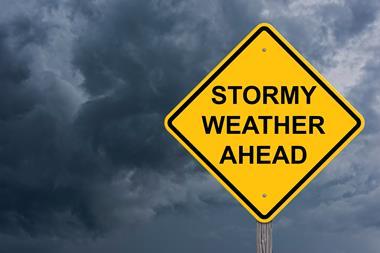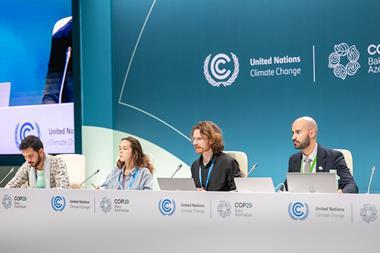’We’re having increasing adverse weather events and it is undeniably off the back of climate change,’ says insurer’s chief executive
Our world’s climate is changing and, with this, we find ourselves facing rising temperatures, melting ice caps and rising sea levels.

The frequency and severity of storms and other extreme weather events are also increasing.
The latest UK storm season has seen the highest number of named storms since the 2015/16 season, with the UK Storm Centre deeming 11 storms severe enough to warrant that designation. The most recent – Kathleen – was christened on 4 April 2024.
But what does this mean for the insurance industry? And how is it changing the way insurers deal with these storms?
For Axa UK chief executive Tara Foley, the situation has certainly moved on from just a few years ago – and named storms can no longer be considered a “one off” for insurers.
“We as an industry need to deal with each and every one of [these storms],” she said.
“They have slightly different impacts, but we have to deal with them. There’s this view that, maybe three or four years ago, we would be calling weather events a one off – I don’t think we can do that anymore.
“We’re having increasing adverse weather events and it is undeniably off the back of climate change.”
But WTW Research Network head of modelling research and innovation Cameron Rye said insurers do have experiences that they can draw on from other areas of the world.
“Named storms have always been a significant consideration for insurers,” he explains.
“In the US, there are typically one or two hurricane landfalls per year. Historically, tropical cyclones have caused the most damage among weather and climate-related events worldwide. But the evolving risk from named storms must be considered from multiple perspectives, not just climate change.
“In recent decades, exposure growth and increasing coastal populations mean that more assets are in the path of storms, leading to greater losses.
”High inflation in recent years has also contributed to rising reconstruction costs. Additionally, ageing infrastructure, such as coastal flood defences, is an increasing risk.”
Risk mitigation
There are measures the insurance industry can take to mitigate the risks presented by named storms, however, and Hannah Davidson, senior underwriting manager for home insurance at Aviva, said increasing the resilience of our infrastructure is key.
Read: Insurance sector in race against time to tackle rising storm challenges
Read: 2023 natural disasters caused £299bn of economic losses globally – Aon
Explore more ESG-related content here or discover other news stories here
“In our Building Future Communities campaign, we have highlighted the benefits of resilience to help protect properties from extreme weather and ensure they are climate-ready against future risk,” she explained.
“Changing weather patterns are likely to increase the frequency of weather events at any time of year and, as our recent analysis highlighted, floods are becoming more common during the summer.
“We believe action is needed to make properties more resilient to the impacts of weather. Aviva, as part of the Flood Re scheme, supports Build Back Better and we have been encouraging resilience measures for many years.”
WTW’s Rye said there are a number of actions that can be taken to mitigate the risks from named storms, including:
-
Retrofitting existing structures and rebuilding after events to enhance resilience, including developing more resilient infrastructure and adhering to updated building codes.
-
Continue investing in climate research and forecasting tools, such as improving the forecasting of rapid intensification.
-
Undertake comprehensive risk assessments using an interdisciplinary approach that combines expert knowledge, climate-conditioned modelling and site-level assessments. This should include quantifying not only direct damages to property but also systemic risks, such as infrastructure failure and operational disruptions.
-
Develop robust, cost-effective risk financing strategies that account for evolving climate and exposure factors and help close the protection gap.
-
Involve communities and stakeholders in risk mitigation efforts. Public awareness campaigns, education on emergency preparedness and community-based resilience projects are crucial.”
It is not solely down to insurers to combat the rising threat from climate change, however, and Foley noted that the industry needs support too. She called on the next government to support the industry in driving down the risks posed by these storms.
“Whoever the government will be, we’ll be very keen to continue our conversations with them around the resilience of properties,” she said.
“So how are we building properties? Where are we building properties? And how are we retrofitting existing properties, given what we’re seeing in terms of climate change?
“That’s a conversation for the government, for industry bodies, for house builders and for insurers.”
“Collaboration is the way forward on all of this, but I think that’s an area that’s very interesting to us,” she added.
Davidson agreed, adding that measures must also be put in place to ensure future buildings are fit-for-purpose in this new climate.
“To help protect properties in future, it is important that we build high quality buildings in the right places using the right materials,” she said.
“Any future planning rules should ideally prevent unsuitable development of homes and commercial buildings in current and future flood zones.
“But in some places, for example in some low-lying areas where building in high risk areas is more difficult, flood mitigation should be built in from the outset.”

Hosted by comedian and actor Tom Allen, 34 Gold, 23 Silver and 22 Bronze awards were handed out across an amazing 34 categories recognising brilliance and innovation right across the breadth of UK general insurance.
























































No comments yet